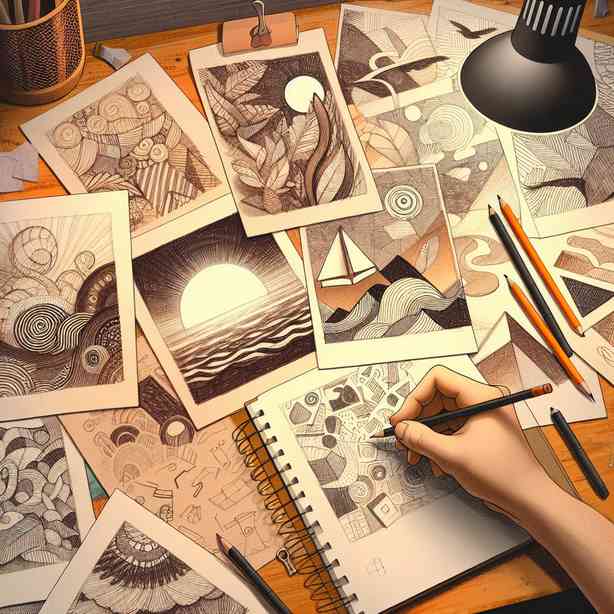
Doodles Say More Than a Finished Piece
Doodles are often dismissed as mere scribbles or casual sketches, but they possess a hidden depth that can reveal a great deal about our thoughts and feelings. While polished artwork certainly has its charm, there’s something uniquely human about the rawness of doodling. This essay will explore the various dimensions of doodling, from its psychological implications to its cultural significance, ultimately revealing why doodles often convey more than meticulously crafted finished pieces.
Doodling is a universal form of expression, accessible to people of all ages and backgrounds. It transcends language barriers and serves as a visual manifestation of thoughts and emotions that may be difficult to articulate verbally. When we doodle, we allow our minds to wander, creating a bridge between conscious and subconscious thoughts. This process can yield surprising insights into our inner worlds. Research has shown that doodling can help improve memory retention and focus. When our hands are engaged in creating simple shapes or patterns, our minds are often freer to absorb and process information. This phenomenon has allowed doodles to become an effective tool in classrooms and professional settings alike.
Furthermore, doodles can serve as a therapeutic outlet. Engaging in doodling can evoke a state of mindfulness, reducing stress and anxiety. As individuals allow themselves to doodle freely, they may find solace in the simplicity of the act. The rhythmic motion of drawing can be meditative, creating a sense of calm and clarity. For those grappling with emotional turmoil, doodling can act as a non-verbal means of expressing complex feelings. This creative engagement provides room for healing, as individuals explore their thoughts and emotions through an open-ended art form.
Additionally, doodling can serve as a reflection of personality traits. The shapes, patterns, and themes we choose to doodle can reveal much about our individual characteristics and preferences. For instance, those who favor geometric shapes might have a preference for structure and order, while those who gravitate toward free-flowing lines may embrace spontaneity and creativity. Understanding one’s doodling style can provide valuable insight into personal tendencies and behaviors.
Culturally, doodles have held significance in various forms of artistry throughout history. From ancient cave paintings to modern-day graffiti, forms of doodling have existed for millennia as a way for individuals to express themselves. Artists often turn to doodles as a starting point for more elaborate works, using them to brainstorm ideas or explore concepts in a relaxed manner. The spontaneity and freedom of doodling can lead to innovative breakthroughs in the artistic process, allowing artists to step outside conventional boundaries.
In the realm of professional creativity, doodling can spur collaboration and innovation. In brainstorming sessions or meetings, individuals are often encouraged to doodle alongside note-taking. This practice not only aids in maintaining focus but also fosters a collaborative spirit. Doodling can serve as a common language among team members, facilitating discussions and generating new ideas through shared visual language. The casual nature of doodling can break down hierarchical barriers, encouraging everyone to contribute without the fear of judgment.
Moreover, the internet has transformed the way we view and appreciate doodles. Social media platforms allow artists to share their doodles with a global audience, celebrating the simplicity and joy of this art form. Online doodling communities have emerged, fostering connections among individuals who share a passion for spontaneous creativity. As doodles gain popularity in the digital sphere, they challenge the notion that art must be polished and perfect to be valuable.
It is essential to recognize that doodling is not merely a pastime; it is a fundamental aspect of human creativity. The freedom to make mistakes and explore ideas without the pressure of perfection is what distinguishes doodling from more formal artistic endeavors. The acts of doodling and sketching can inspire creativity by encouraging exploration and play. In a world that often prioritizes results over the creative process, doodling invites us to reconnect with the joy of creation.
In educational contexts, promoting doodling can enhance learning experiences. Instructors can encourage students to take more creative approaches to their studies by allowing them to doodle while learning. This approach not only makes lessons more engaging but also helps students retain information better. Learning environments that embrace doodling can foster an atmosphere where students feel comfortable exploring their thoughts and connecting them to their studies.
In conclusion, doodles encompass a rich tapestry of meaning that goes beyond mere decoration. They serve as a powerful tool for self-expression, creativity, and exploration. The act of doodling invites us to engage with our thoughts and feelings in a way that finished pieces cannot. Whether in a classroom, workspace, or personal setting, doodles have the potential to unveil our inner worlds, stimulate conversation, and foster a deeper understanding of ourselves and each other. Embracing doodles can enrich our lives and encourage a more profound appreciation for the creative journey that lies within us all. By recognizing the importance of doodling, we can create space for spontaneity, innovation, and connection in our everyday lives.


